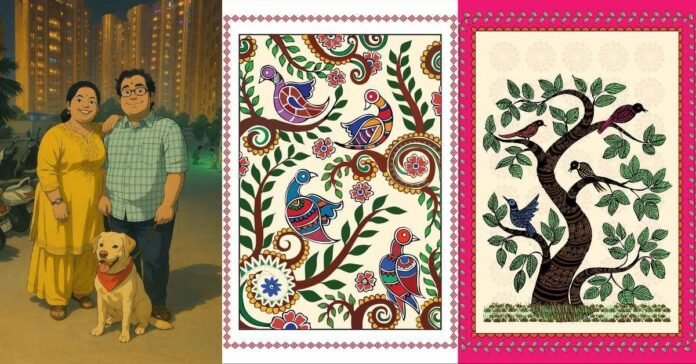
The Rise of Ghibli-Style AI Art
Your social media feed is likely flooded with dreamy, hand-painted visuals labeled “Ghibli-style.” From celebrities to everyday users, everyone seems enchanted by this aesthetic transformation. But what exactly is Ghibli, and why has it taken over the internet?
The Story Behind Ghibli Art
Studio Ghibli was founded in Japan on June 15, 1985, by legendary animators Hayao Miyazaki and Isao Takahata, along with producer Toshio Suzuki. The studio’s name, “Ghibli,” is derived from the Italian word for a hot desert wind, symbolizing its mission to bring a fresh breeze to the animation industry.
Ghibli’s influence extends far beyond Japan, inspiring generations of artists worldwide. Its films are celebrated for their rich storytelling, breathtaking visuals, and deep themes exploring nature, identity, and human resilience. The meticulous hand-drawn animation, watercolor backgrounds, and strong female protagonists make Ghibli’s works stand apart in the world of animation.
In 2001, Studio Ghibli even opened the Ghibli Museum in Mitaka, Tokyo, offering fans an interactive glimpse into their creative process. Despite Miyazaki’s brief retirement in 2013 (before returning for The Boy and the Heron in 2023), the studio remains a cornerstone of global animation, influencing artists, filmmakers, and pop culture worldwide.

AI Meets Ghibli: What Do Indian Artists Think?
While the new AI-powered Ghibli-style art transformation has taken social media by storm, reactions from artists remain mixed. Some embrace it as a fun trend, while others question its impact on artistic authenticity and originality.
Krishna (name changed), a game designer in a leading Indian organization, acknowledges AI’s growing role in digital art. “Having worked in game design and digital art for over two decades, I’ve drawn inspiration from countless sources. AI tools now allow us to generate multiple ideas with just a click. While I don’t believe AI can replace traditional art, it has certainly entered the creative pipeline, saving time in manual processes.”
However, Krishna also raises concerns: “AI-generated imagery often remixes human-made art without proper attribution, leading to copyright concerns. Where do we draw the line between inspiration and infringement?”
Another Chennai-based artist, Muralidharan Alagar, shared his mixed feelings: “We put immense creativity into our work—from color choices to the core concept of a piece. Seeing AI create something similar in seconds can be disheartening. Yet, on the other hand, AI and Ghibli-style transformations have increased public interest in art.”
Puducherry-based artist Rajkumar Sthabathy remains confident in the uniqueness of human art. “My work reflects my personality. That’s something AI can’t replicate,” he asserts.
Mumbai-based watercolor specialist Vikrant Dattapreya Shitole agrees, adding, “Art is about expression and personal satisfaction, something AI lacks. Ethically, using AI to recreate established art styles feels problematic.”
Beyond AI: India’s Timeless Artistic Heritage
While AI-generated Ghibli art dominates online spaces, it has also sparked renewed interest in artistic originality and ethics. But beyond this debate, there’s an equally important conversation—one about India’s rich artistic traditions. Instead of chasing fleeting digital trends, why not explore and celebrate homegrown art forms that have stood the test of time?
Madhubani Art: A Legacy of Storytelling

Madhubani, or Mithila painting, is a traditional Indian folk art known for its intricate patterns, bold lines, and vibrant natural colors. Depicting mythology, nature, and cultural themes, this style originated in the Mithila region of Bihar and Nepal as early as the 7th century. Women traditionally painted these designs on their home walls during festivals and special occasions as a form of religious expression.
Today, Madhubani art has evolved beyond murals, appearing in contemporary fashion, home décor, and digital adaptations while preserving its cultural essence.
Amar Chitra Katha: India’s Visual Storytelling Tradition
For those drawn to Ghibli-style animation, India’s own Amar Chitra Katha offers a visually engaging alternative. Founded in 1967 by Anant Pai, this iconic comic book series illustrates mythological tales, epics, and historical narratives in a vivid, accessible style. Even today, Amar Chitra Katha remains a cultural phenomenon, available as books, digital comics, and online content.
Kalamkari: The Art of ‘Pen Work’

Kalamkari, meaning ‘pen work,’ is an intricate textile art form from Andhra Pradesh and Telangana, dating back 3,000 years. Initially used by musicians and painters to narrate mythological stories on temple canvases, Kalamkari has since become a sought-after art form in textiles and home décor. The two primary styles—Srikalahasti (freehand painting) and Machilipatnam (block printing)—continue to captivate art lovers worldwide.
Raja Ravi Varma’s Timeless Elegance

For those who admire the sophistication of Ghibli’s art, Raja Ravi Varma’s European-influenced Indian paintings offer a timeless aesthetic. Known for portraying South Indian women and Hindu deities in a classical, lifelike manner, Varma’s works remain iconic in Indian visual culture. His paintings are widely used in religious art, framed prints, and cultural exhibitions.
Preserving Art in the Age of AI
AI is undoubtedly transforming the art world, but India’s artistic heritage continues to shine. Instead of solely chasing digital trends, let’s celebrate and support our country’s incredible creative traditions. The next time you admire an AI-generated image, take a moment to explore the rich tapestry of Indian art that has shaped our culture for centuries.

